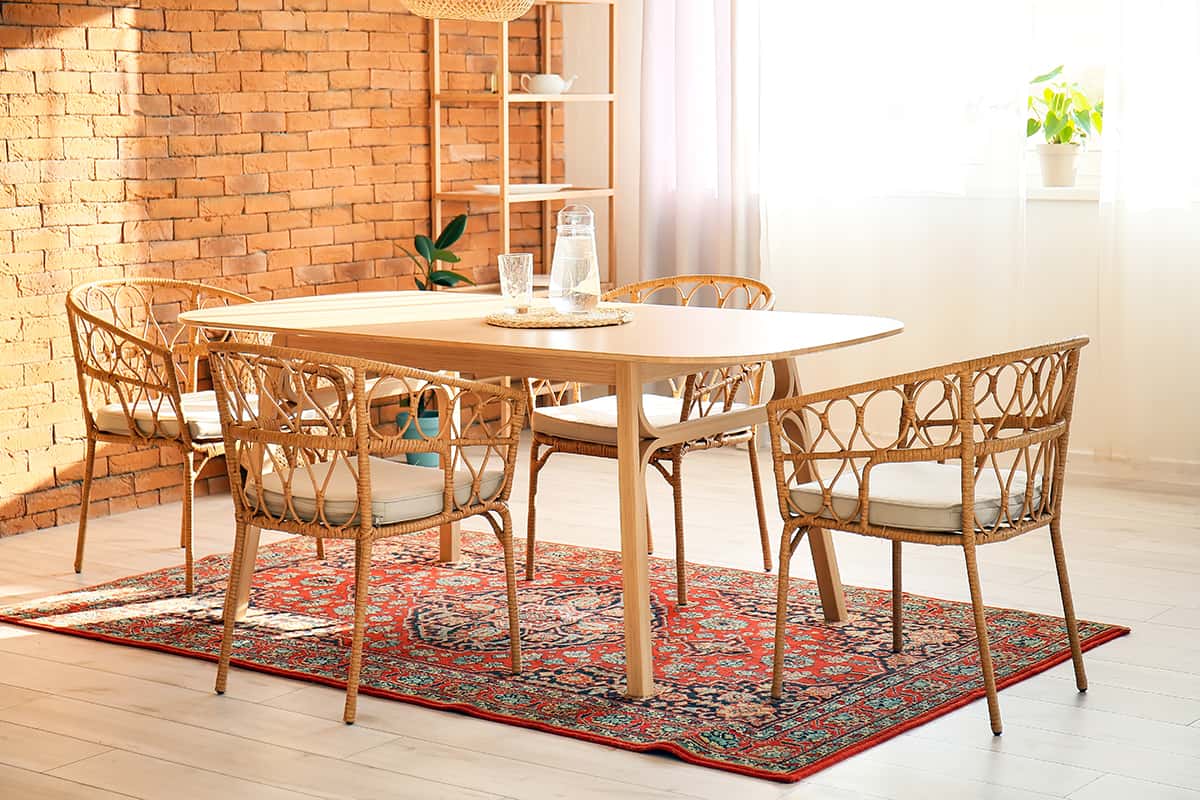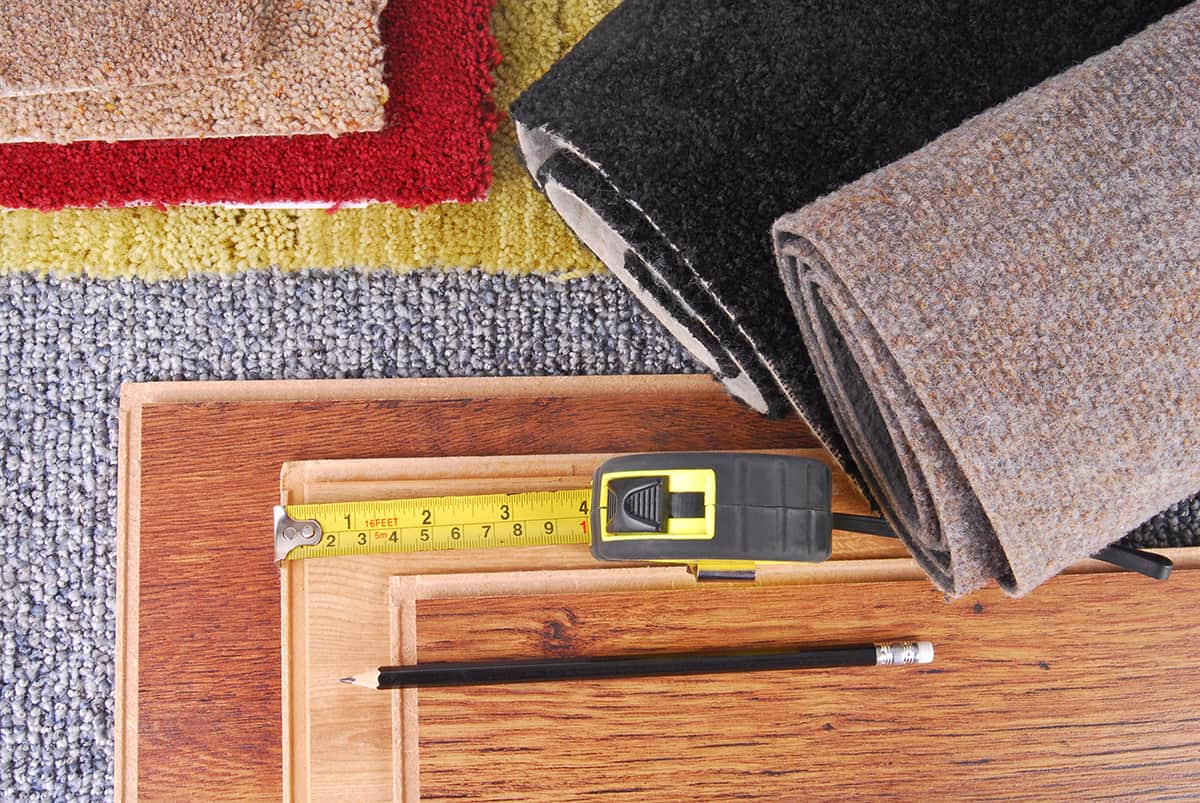A rug adds style and comfort to any room, but dining rooms, in particular, can benefit from the addition of a rug in both practical and aesthetic terms. If your dining room has a hard floor surface, then a rug can soften the sound of chairs moving when people position themselves at the dining table. A rug can also serve as a protective surface to avoid scuffs and scratches from damaging the floor.
You’ll need to choose a suitable rug size for the dining room, which needs to relate to the size of your dining table. Here we explain which size of dining room rug you need according to the size of your table.
Should a Dining Room have a Rug?
Dining rooms don’t have to have a rug, but they can add both comfort and style to the space, as well as limit noise and protect the floor. Bear in mind though that rugs can be difficult to clean, so they aren’t the best option for families with young children where food may get spilled onto the floor beneath the table. Here, we explore the pros and cons of having a rug in the dining room.
Pros
Comfort
A rug can create comfort underfoot so that bare feet feel soft and cushioned when sitting at the dining table. Rugs will also feel warmer against bare feet compared to a hard surface floor, which can increase comfort.
Style
Dining rooms can feel quite vacant and bland because they typically don’t include a lot of furniture or accessories. Adding a rug allows you to incorporate more colors and textures into the room, which can help you showcase your style.
Texture
Rugs provide a soft texture to a dining room, creating a more comforting and welcoming energy. The more soft textures you have in a space, the more cozy and at home you will feel.
Soften sounds
Rugs soften the noise created by dining chairs, which might squeak or bang when they are pulled out from under the table. Rugs will prevent these annoying sounds from happening, which can be especially helpful if you have babies or children sleeping during mealtimes.
Protect floor
One of the main benefits of a dining room rug is that it protects the floor from scratches and scuffs. If you have a hardwood floor, you might be particularly concerned about causing surface damage to the floor, and this can be prevented with a rug.
Cons
Easily stained
Rugs can be easily stained, so if you anticipate that food and drink spillages will find their way beneath the dining table, then a rug may not be the best idea. If you have toddlers who are learning how to eat, a rug could very quickly become stained with a range of purees. If you have your heart set on a rug but are concerned about stains, opt for a stain-proof rug.
How to Measure for a Dining Room Rug
It’s important that a dining room rug works with the size of the dining table. This is to ensure that the floor is properly protected from the feet of dining chairs as they are moved out from under the table and also to prevent people from tripping on the edges of the rug when moving chairs. If the rug isn’t big enough for all four feet of a chair to rest on, people using the chairs may also feel off-balance.
The best way to measure for a dining room rug is to measure your dining table and work from there. The rug should be 2 feet bigger than the dining table on all sides, which will allow enough space for chairs to be moved and remain on the rug. To work out which size of rug you need, measure your dining table and add 4 feet onto each measurement.
For example, if your dining table measures 3 feet by 6 feet, then you will need a rug that measures 7 feet by 10 feet. If your dining room is small and you can’t accommodate 2 feet of rug space around each edge of the dining table, you can lower this to 1.5 feet (18 inches) if necessary.
To work out your rug size in this case, add 3 feet to both of your table measurements. For example, with a table measuring 3 feet by 6 feet, your rug should be at least 6 feet by 9 feet.
Rug Sizes According to Dining Table
2 to 3-seater table
Round tables that sit 2 to 3 people will typically measure around 36 inches in diameter, which equates to 3 feet. If you want a round rug to place beneath this type of dining table, it should have a diameter of between 6 and 10 feet.
4 seater table
4 seater tables come in round, oval, square, or rectangular options. A round 4-seater table will typically measure 42 inches across, so a rug for this table should measure between 6 and a half and 10 and a half feet. If your 4 seater table is square shaped, it will typically measure 3 feet by 3 feet or 4 feet by 4 feet.
This means the rug will need to be anywhere from 6 feet by 6 feet to 10 feet by 10 feet. In most cases, a rug measuring 8 feet by 8 feet will work for a range of 4-seater dining tables.
6 seater table
A 6-seater rectangular dining table will be compatible with a rug measuring around 8 feet by 10 feet. You can opt for a rug larger than this if you wish, but any smaller rug will feel out of proportion with the table.
8 seater table
8 seater tables can measure as much as 3 and a half feet by 10 feet. For this size of table, you will need a rug that measures a minimum of 6 and a half feet by 13 feet.








